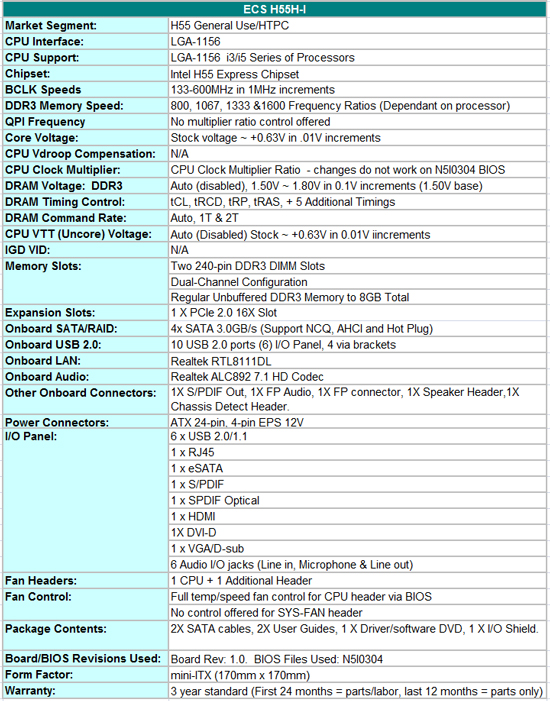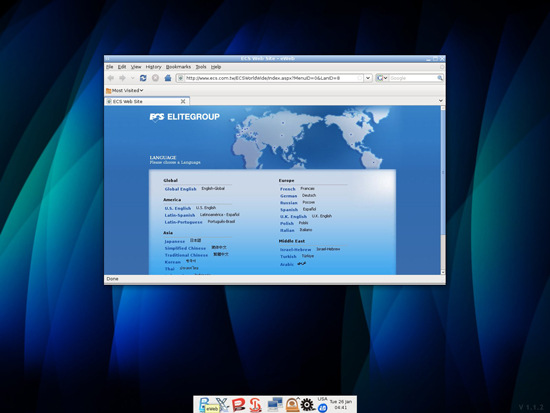ECS H55H-I Review: Mini-ITX at a Sensible Price
by Rajinder Gill on May 6, 2010 6:59 AM EST- Posted in
- Motherboards

It’s pleasing to see that ECS have decided to go with the more popular Realtek Codec for audio rather than using the VIA VT1705 we saw used on the H55H-M model earlier this year.
Component choices elsewhere on the board are pretty much the norm at this price, so we don’t have any real nit-picking to do.
What’s in the box?
- 2 SATA Cables
- 2 Manuals
- Rear I/O Shield
An unremarkable bundle, It's exactly what we expected to find. We’d probably have liked a couple more SATA cables, but won’t beat ECS up over it because RAID is off the menu with H55.
Software
The only thing included on the driver disc as an extra is ECS’s eJiffy:

eJiffy features a web browser, photo editing and chat functionality without having to boot into your primary OS. Before eJiffy can be used though, you have to install it onto your hard drive via your primary OS. Once you've done that, you'll find it takes just as long to boot into Windows 7 as it does to boot eJiffy - we fail to see the appeal of this software.
BIOS
There’s nothing remarkable to report about the BIOS. It’s fairly basic but could be laid out a little better. The CPU C-State options are under the Advanced Setup menu, while all the overclocking stuff resides under the MIB II (Motherboard Intelligent BIOS II) section. Having both in one area would make a more logical choice.
Curiously ECS opts to switch Turbo mode off by default, we’re not quite sure why this is the case, because it’s a stock supported parameter. If you want Turbo mode to function on supporting processors you’ll have to turn it on yourself.
The MIB Overclocking section offers control of BCLK, CPU Vcore, VTT, and VDIMM. Voltage scale settings for VCore and VTT rails are in 63 incremental steps, using 0.01V increments to a maximum over-voltage of 0.63V. VDIMM gets 0.1V steps to a maximum of 1.8V. There’s no control on offer for QPI multiplier ratios, IGP voltage or IGP clock multiplier ratios which will limit BCLK overclocking somewhat (although BCLK overclocking is hampered anyway - see below).
An option to change CPU multiplier ratios is present, but does not work; the board won’t POST if you use anything other than the stock multiplier. We saw this issue on the H55H-M we reviewed a couple of months ago, so are not sure if ECS will ever bother to fix it.
Fan control is available for the 4 pin CPU header only and only works with PWM fans. The range of control on offer is very granular allowing manipulation of the ramp slope per Celsius increment, as well as the ability to offset the temperature sensor. A voltage control mode for 3 pin headers would have been a nice touch, although we’re willing to overlook that given the small footprint of this board is best suited to Intel’s stock CPU cooler.
One last gripe we have is that ECS do not provide any kind of built-in BIOS flashing routine. BIOSes must be flashed from within the OS, or by using a bootable USB drive.














67 Comments
View All Comments
Marlin1975 - Thursday, May 6, 2010 - link
Is Realtek Codec really better than the VIA? I don;t build systems as much as I use to and VIA use to make better Audio Codecs.That and I wish small boards like this would include a built in wireless chip. I know you can use a USB one but the idea of a system like this is small. So to have extra cables and items hanging off it takes away from it. Could be just a very basic one.
Rajinder Gill - Thursday, May 6, 2010 - link
The VIA comment was made in respect of ECS' implementation on the ECS H55H-M that we reviewed a couple of months ago. Same price for the board, but limited Audio out optionshttp://www.anandtech.com/show/2945/2
I should have clarified that better.
Taft12 - Thursday, May 6, 2010 - link
But is it the VIA codec that limits ECS' microATX board to only 3 audio I/O jacks + no SPDIF? Or is that just a matter of ECS not providing the connectors? I'm still not clear.Do any audiophile readers know which is technically superior between VIA and Realtek audio?
mindless1 - Thursday, May 6, 2010 - link
Any modern codec (family, meaning they can make defeatured parts for cost conscious buyers) from Via or Realtek offers 5.1 or more channel output.The issue is not really codec quality, it is board design and PSU selection which determines how much noise gets into the analog circuits. For digital, it's still 1's and 0's.
Point being, roll the dice and take your chances, there are lots of good and bad audio implementations using the very same chips.
For HTPC, what about HDMI audio? Why even bother with onboard analog codec for this purpose?
Rajinder Gill - Thursday, May 6, 2010 - link
From everything I can find, the VT1705 is a 6 channel device, so limited on the analog I/O side. Unfortunately, I can't find a datasheet online so don't know if there are any features ECS chose not to implement. What I will say is that had the features been available I'm sure ECS would have used them. Vendors tend to buy devices like these in bulk, so will utilize them on a wdie range of boards where possible - unless there's a problem.As for arguments about whether or not analogue outputs are needed when HDMI audio is available, this is another area (like the legacy devices) where people have downstream hardware they'd like to use.
Regards
Raja
kake - Saturday, August 21, 2010 - link
One way to get around having an external USB wifi adapter is to use the internal USB header and put the USB adapter inside the case with it. Works a treat.BansheeX - Thursday, May 6, 2010 - link
But the lack of PS2 ports is a con? It's 2010 for cripes sake. If you have a USB mouse and keyboard, then PS2 eats into USB availability. Also detestable is IDE and floppy eating into SATA ports. Being mini-ITX, thank god the board is legacy free, I say.Rajinder Gill - Thursday, May 6, 2010 - link
You're right. I was thinking along the lines of desktop use where people tend to hold on to legacy devices a little too long..IanCutress - Thursday, May 6, 2010 - link
People will upgrade all sorts of things, but you will see those still using a PS2 keyboard and mouse, just because they still work. Also in environments where expensive equipment is used based on old connections (floppy, serial), where it's cheaper to buy a new computer than to buy a new $100k piece of hardware with the newest port, then legacy connectors come into play. It's all very well saying 'thankfully this or that has been removed', but at the end of the day, some people still need them and they're included to widen the market. I have some equipment here in my lab (chemistry) that requires ISA cards; upgrading those computers is always a hassle, trying to find a cheap Core 2 motherboard with ISA ports. Legacy markets are always bigger than you think.Ian
DanNeely - Thursday, May 6, 2010 - link
I'm shocked that you can find one at all. Where are boards like that hiding?